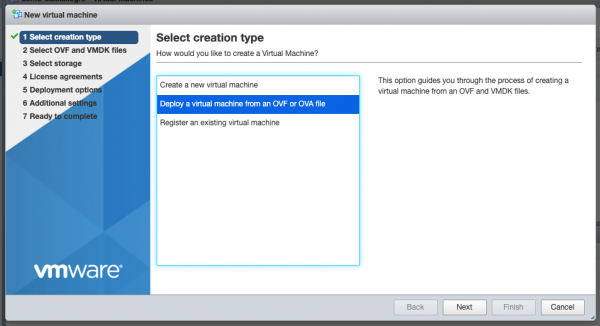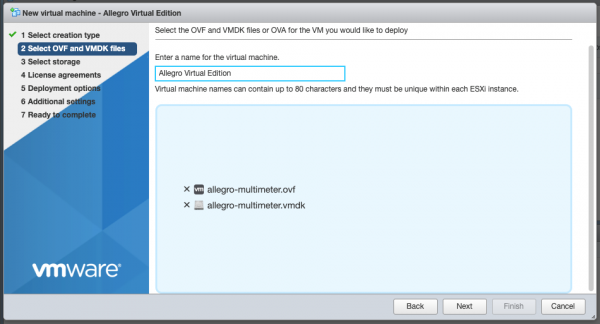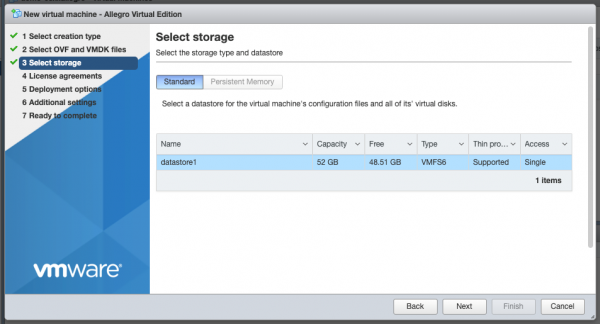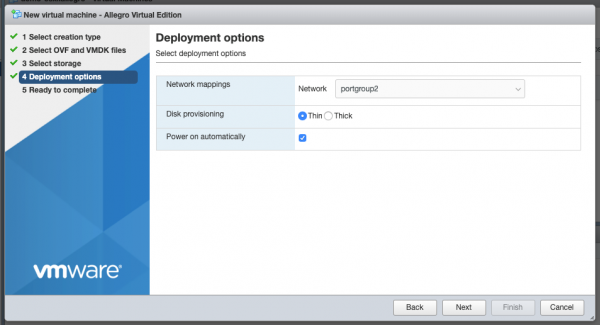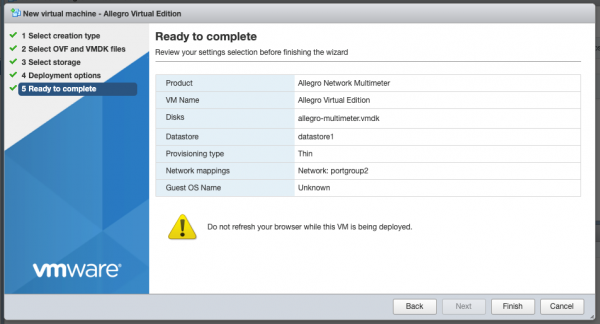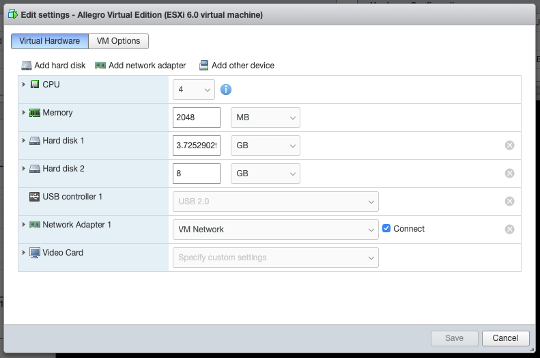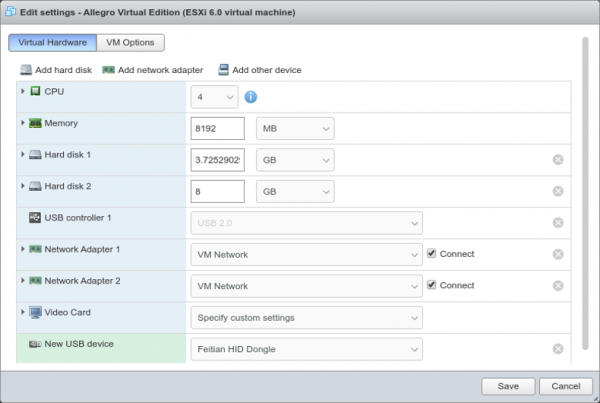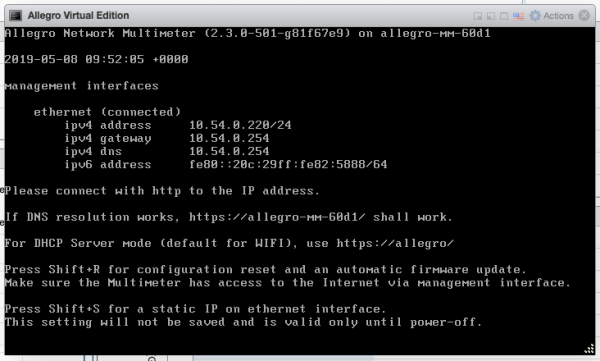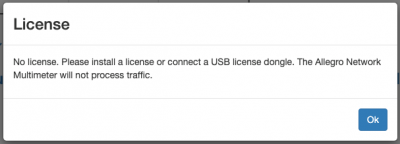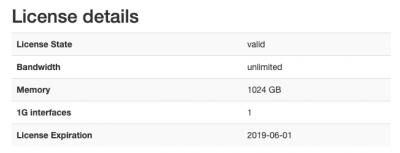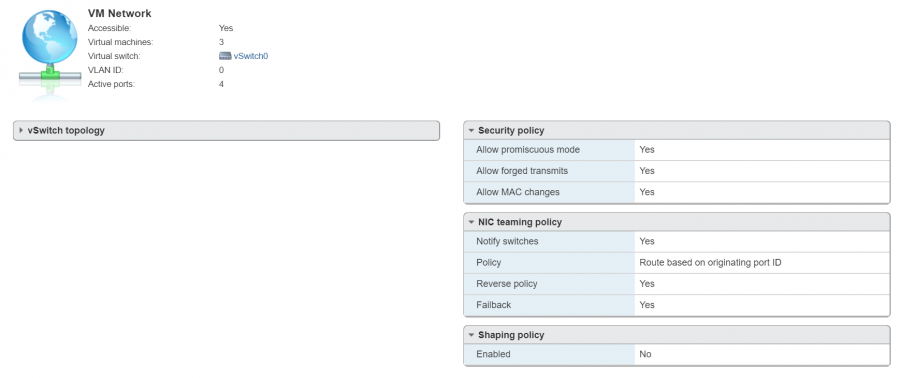VMWare ESXI Installation Guide: Difference between revisions
Remco.derooy (talk | contribs) |
|||
| (54 intermediate revisions by 5 users not shown) | |||
| Line 1: | Line 1: | ||
This guide describes how the Allegro Network Multimeter Virtual Edition can be set up with VMWare ESXI. The Allegro Virtual Edition is designed for 2 use cases. It can analyze [[Parallel | This guide describes how the Allegro Network Multimeter Virtual Edition can be set up with VMWare ESXI. | ||
The Allegro Virtual Edition is designed for 2 use cases. | |||
# It can analyze [[Parallel packet processing|pcap captures]] or [[Ring Buffer Configuration Guide|packet ring buffers]] of unlimited size for forensic investigation and/or | |||
# it can analyze live traffic from virtual machines by a virtual Mirror Port or [[ERSPAN Installation|ERSPAN]]. | |||
== General == | == General == | ||
| Line 5: | Line 10: | ||
=== DISCLAIMER === | === DISCLAIMER === | ||
Be aware that an activated | Packet analysis is resource intensive. Running the Allegro Packets VM on your own hardware and its performance outcome is warranted “as is”. Our support will be limited. | ||
Be aware that an activated ring buffer can (heavily) degrade the I/O performance for all VMs. It is strongly recommended to use one or more dedicated HDDs or SSDs for the ring buffer, to prevent side effects on other VMs. | |||
=== System requirements === | === System requirements === | ||
| Line 11: | Line 18: | ||
This guide requires a licensed VMWare ESXi 6.7.0 or newer. | This guide requires a licensed VMWare ESXi 6.7.0 or newer. | ||
The system requirement of the virtual machine is | The system requirement of the virtual machine is: | ||
* x86 64-Bit Intel/AMD CPU with SSE4.2 support ( since 2011 ) | * x86 64-Bit Intel/AMD CPU with SSE4.2 support (since 2011) | ||
* 4 CPU-Cores | * 4 CPU-Cores | ||
* at least 2GB RAM for the In-Memory-DB, the larger the better | * at least 2GB RAM for the In-Memory-DB, the larger the better | ||
| Line 19: | Line 26: | ||
=== Virtual Machine image === | === Virtual Machine image === | ||
Please contact [https://allegro-packets.com/en/contact Allegro] or your reseller to | Please contact [https://allegro-packets.com/en/contact Allegro] or your reseller to download the current Allegro Virtual Edition installation zip archive. | ||
== Installation == | == Installation == | ||
| Line 25: | Line 32: | ||
=== Zip file extraction === | === Zip file extraction === | ||
Please extract | Please extract the zip archive. It should contain the 3 files “allegro-multimeter.ovf”, “allegro-multimeter.vmdk” and “allegro-multimeter-virtualbox.ovf”. | ||
=== OVF deployment to VMWare ESXi === | === OVF deployment to VMWare ESXi === | ||
Log in to VMWare ESXi. | |||
[[File:Esxi login.png|400px]] | [[File:Esxi login.png|400px]] | ||
| Line 41: | Line 48: | ||
[[File:Esxi create new vm.png|600px]] | [[File:Esxi create new vm.png|600px]] | ||
Press “Next”, use a preferred name for the Allegro and drag/drop the | Press “Next”, use a preferred name for the Allegro and drag/drop the ovf and vmdk files into the window (as seen in the picture below) and press “Next”. | ||
[[File:Esxi create new vm step 2.png|600px]] | [[File:Esxi create new vm step 2.png|600px]] | ||
Select your data storage for the Allegro. This storage will be used as the boot partition and to store the configuration of the Allegro Virtual Edition | Select your data storage (20 GB is enough) for the Allegro. This storage will be used as the boot partition and to store the configuration of the Allegro Virtual Edition. | ||
This partition/disk will NOT facilitate the packet ring buffer functionality. This does not require a high-speed disk. | |||
[[File:Esxi create new vm select storage.png|600px]] | [[File:Esxi create new vm select storage.png|600px]] | ||
The | The deployment options allow you to select the network mapping for the MGT port and the disk provisioning. | ||
[[File:Esxi create new vm management.png|600px]] | [[File:Esxi create new vm management.png|600px]] | ||
Please double-check all options in the next | Please double-check all options in the next dialogue and press finish if everything is fine. | ||
[[File:Esxi create new vm finish.png|600px]] | [[File:Esxi create new vm finish.png|600px]] | ||
The upload and | The upload and import of the Allegro Virtual Edition will start. Please be patient until it is finished. | ||
[[File:Esxi import.png|600px]] | [[File:Esxi import.png|600px]] | ||
== | === Packet ring buffer and pcap storage === | ||
For the ring buffer to work, you must add a "Hard disk 2" virtual disk (or more) to the Allegro Virtual Edition. | |||
To do so, with a turned off VM, press “Edit” in the Vmware ESXi host and add a new (high speed) HDD. | |||
[[File:Esxi add hdd.png]] | |||
When done, power on the Allegro VM and go to menu '''Generic''' → '''Storage''', to check if the Allegro Network Multimeter has detected a storage device. | |||
Here an example of 1 attached/configured disk: | |||
[[File:Storage no device active.png|border|600px]] | |||
Please | Here, on the '''Generic''' → '''Storage''' page, you can prepare the disks to be used by the Allegro by clicking the "Format" button. | ||
The VM will | |||
This will erase all content on the disk and create the filesystem for the Allegro. You can also activate and deactivate the storage device for pcap files here. | |||
For more information on the ring buffer, please review the corresponding page here → [[Ring Buffer Configuration Guide]]. | |||
'''Disclaimer:''' Be aware that an activated ring buffer can (heavily) degrade the I/O performance for all VMs. | |||
It is strongly recommended to use one or more dedicated HDDs or SSDs for the ring buffer, to prevent side effects on other VMs. | |||
=== Install USB License dongle === | |||
If the Allegro Virtual Edition is shipped with an USB License dongle, plug the dongle into an unused USB port of the VM host. The dongle must be connected to the virtual machine. When powered off, press “Edit” in the Vmware ESXi host and click on “Add other device”. Choose “USB device”. A new entry on the bottom of the hardware list appears. Please select a “Feitian HID Dongle” or similar. | |||
[[File:License dongle.png|600px]] | |||
== Initial startup == | |||
=== Powering on === | |||
Power on the virtual machine when the import has been successful. The Allegro Virtual Edition will boot, prepare the installation and reboot once. | |||
The VM will seek for an IP address via DHCP on the MGT port. Check the screen output for an assigned IP address. | |||
[[File:Esxi allegro screen.png|600px]] | [[File:Esxi allegro screen.png|600px]] | ||
You can connect | You can now connect to the IP address with your browser, in our case https://10.54.0.220/ . The browser will show a certificate warning. Accept it to access the login screen. | ||
[[File:Esxi allegro login.png|600px]] | [[File:Esxi allegro login.png|600px]] | ||
Please use | Please use the following login credentials; user “admin” and password “allegro”. | ||
=== License === | |||
If the Allegro Virtual Edition was shipped with a USB License dongle and it has been correctly installed, the License is validated and the Allegro should activate. | |||
The serial number of the Allegro Virtual Edition would be e.g. “dongle: 1234567890” and is displayed in the serial number box under “Settings” -> “License upload”. If it is not displayed even though the dongle has been correctly installed, please contact Allegro support. | |||
If the Allegro Virtual Edition was shipped without an USB License dongle, please follow the following steps. In the web interface a warning is shown that the Allegro Virtual Edition does not yet have a License. | |||
[[File:Esxi allegro license.png|400px]] | [[File:Esxi allegro license.png|400px]] | ||
Navigate to “Settings” -> “License upload” and send the system serial number to testlicense@allegro-packets.com. | |||
Allegro Packets will issue a test | |||
Once the | Allegro Packets will issue a test License for you that can be installed by the “Upload new License button”. | ||
Once the test License is applied, it will show you the License details similar to this output: | |||
[[File:Esxi allegro license details.png|400px]] | [[File:Esxi allegro license details.png|400px]] | ||
The Allegro Virtual Edition is now running and | The Allegro Virtual Edition is now running and analyzes all packets on the capture port. | ||
== Mirroring virtual interface == | == Mirroring virtual interface == | ||
The Allegro Virtual Edition has by default 2 network interfaces. The first port is used for Management, the second | The Allegro Virtual Edition has by default 2 network interfaces. The first port is used for Management, the second is used as capture port. The Allegro Virtual Edition will analyze all traffic received by this network port. | ||
Please enable the promiscuous mode for the vwsitch to allow the Allegro Virtual Edition to monitor all packets from on a VMWare vswitch. | Please enable the promiscuous mode for the vwsitch to allow the Allegro Virtual Edition to monitor all packets from on a VMWare vswitch. | ||
| Line 93: | Line 142: | ||
[[File:Esxi switch allow promicuous mode.png|900px]] | [[File:Esxi switch allow promicuous mode.png|900px]] | ||
== Encapsulated remote mirroring (L3) source == | |||
== Encapsulated | |||
The Allegro Virtual Edition supports the VMware '''Encapsulated | The Allegro Virtual Edition supports the VMware '''Encapsulated remote mirroring (L3) source''' with the [[ERSPAN Installation|ERSPAN Mode]]. You can set up an IP address on the capture port and send encapsulated packets to the Allegro. Please see the Vsphere documentation center for Encapsulated remote mirroring (L3) source. | ||
Latest revision as of 08:38, 26 October 2021
This guide describes how the Allegro Network Multimeter Virtual Edition can be set up with VMWare ESXI.
The Allegro Virtual Edition is designed for 2 use cases.
- It can analyze pcap captures or packet ring buffers of unlimited size for forensic investigation and/or
- it can analyze live traffic from virtual machines by a virtual Mirror Port or ERSPAN.
General
DISCLAIMER
Packet analysis is resource intensive. Running the Allegro Packets VM on your own hardware and its performance outcome is warranted “as is”. Our support will be limited.
Be aware that an activated ring buffer can (heavily) degrade the I/O performance for all VMs. It is strongly recommended to use one or more dedicated HDDs or SSDs for the ring buffer, to prevent side effects on other VMs.
System requirements
This guide requires a licensed VMWare ESXi 6.7.0 or newer.
The system requirement of the virtual machine is:
- x86 64-Bit Intel/AMD CPU with SSE4.2 support (since 2011)
- 4 CPU-Cores
- at least 2GB RAM for the In-Memory-DB, the larger the better
- 20GB free disk space
Virtual Machine image
Please contact Allegro or your reseller to download the current Allegro Virtual Edition installation zip archive.
Installation
Zip file extraction
Please extract the zip archive. It should contain the 3 files “allegro-multimeter.ovf”, “allegro-multimeter.vmdk” and “allegro-multimeter-virtualbox.ovf”.
OVF deployment to VMWare ESXi
Log in to VMWare ESXi.
Once you have logged in, navigate to “Virtual Machines”
Create a new VM with “Create / Register VM” and select the option “Deploy a virtual machine from an OVF or OVA file”.
Press “Next”, use a preferred name for the Allegro and drag/drop the ovf and vmdk files into the window (as seen in the picture below) and press “Next”.
Select your data storage (20 GB is enough) for the Allegro. This storage will be used as the boot partition and to store the configuration of the Allegro Virtual Edition.
This partition/disk will NOT facilitate the packet ring buffer functionality. This does not require a high-speed disk.
The deployment options allow you to select the network mapping for the MGT port and the disk provisioning.
Please double-check all options in the next dialogue and press finish if everything is fine.
The upload and import of the Allegro Virtual Edition will start. Please be patient until it is finished.
Packet ring buffer and pcap storage
For the ring buffer to work, you must add a "Hard disk 2" virtual disk (or more) to the Allegro Virtual Edition.
To do so, with a turned off VM, press “Edit” in the Vmware ESXi host and add a new (high speed) HDD.
When done, power on the Allegro VM and go to menu Generic → Storage, to check if the Allegro Network Multimeter has detected a storage device.
Here an example of 1 attached/configured disk:
Here, on the Generic → Storage page, you can prepare the disks to be used by the Allegro by clicking the "Format" button.
This will erase all content on the disk and create the filesystem for the Allegro. You can also activate and deactivate the storage device for pcap files here.
For more information on the ring buffer, please review the corresponding page here → Ring Buffer Configuration Guide.
Disclaimer: Be aware that an activated ring buffer can (heavily) degrade the I/O performance for all VMs.
It is strongly recommended to use one or more dedicated HDDs or SSDs for the ring buffer, to prevent side effects on other VMs.
Install USB License dongle
If the Allegro Virtual Edition is shipped with an USB License dongle, plug the dongle into an unused USB port of the VM host. The dongle must be connected to the virtual machine. When powered off, press “Edit” in the Vmware ESXi host and click on “Add other device”. Choose “USB device”. A new entry on the bottom of the hardware list appears. Please select a “Feitian HID Dongle” or similar.
Initial startup
Powering on
Power on the virtual machine when the import has been successful. The Allegro Virtual Edition will boot, prepare the installation and reboot once. The VM will seek for an IP address via DHCP on the MGT port. Check the screen output for an assigned IP address.
You can now connect to the IP address with your browser, in our case https://10.54.0.220/ . The browser will show a certificate warning. Accept it to access the login screen.
Please use the following login credentials; user “admin” and password “allegro”.
License
If the Allegro Virtual Edition was shipped with a USB License dongle and it has been correctly installed, the License is validated and the Allegro should activate.
The serial number of the Allegro Virtual Edition would be e.g. “dongle: 1234567890” and is displayed in the serial number box under “Settings” -> “License upload”. If it is not displayed even though the dongle has been correctly installed, please contact Allegro support.
If the Allegro Virtual Edition was shipped without an USB License dongle, please follow the following steps. In the web interface a warning is shown that the Allegro Virtual Edition does not yet have a License.
Navigate to “Settings” -> “License upload” and send the system serial number to testlicense@allegro-packets.com.
Allegro Packets will issue a test License for you that can be installed by the “Upload new License button”.
Once the test License is applied, it will show you the License details similar to this output:
The Allegro Virtual Edition is now running and analyzes all packets on the capture port.
Mirroring virtual interface
The Allegro Virtual Edition has by default 2 network interfaces. The first port is used for Management, the second is used as capture port. The Allegro Virtual Edition will analyze all traffic received by this network port.
Please enable the promiscuous mode for the vwsitch to allow the Allegro Virtual Edition to monitor all packets from on a VMWare vswitch.
Encapsulated remote mirroring (L3) source
The Allegro Virtual Edition supports the VMware Encapsulated remote mirroring (L3) source with the ERSPAN Mode. You can set up an IP address on the capture port and send encapsulated packets to the Allegro. Please see the Vsphere documentation center for Encapsulated remote mirroring (L3) source.


